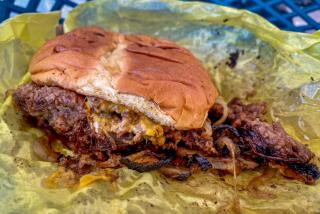Want lies with that?
- Share via
THE HAMBURGER is America’s iconic sandwich, a sizzling symbol recognized from China to Peru. With all due respect to the bustling port city of Hamburg, Germany, a dish of chopped or minced beef (which that city’s residents, and others, have been eating for centuries) is not the same as the sandwich we think of as the quintessential American invention. And now the perennial question of who invented the hamburger is in the news again. Texas state legislator Betty Brown has introduced a bill to codify the oft-repeated claim that “Fletch” Davis, an Athens, Texas, grill man, created the burger and introduced it to the world at the 1904 St. Louis World’s Fair.
The Lone Star State’s attempt to stake its claim on hamburger history caused an explosive reaction in New Haven, Conn., home of the venerable Louis’ Lunch restaurant, which has its own long-standing claim. Other claimants, such as Seymour, Wis., and Hamburg, N.Y., have entered the debate. But none of these claims is persuasive, and the most likely inventor of the hamburger is a person whose name is unknown to most Americans, though we’re all familiar with the restaurant he founded.
First, Texas’ claim. A small library of food histories has for years been circulating this tale, which was popularized by a Dallas newspaper columnist, Frank Tolbert, in his 1983 book, “Tolbert’s Texas.” Invariably, they repeat Tolbert’s assertion that a reporter for the New York Tribune wrote from the 1904 fair of a new sandwich called a hamburger, “the innovation of a food vendor on the pike.” My research assistant, Andrea Murphy, and I have painstakingly looked through the Tribune’s archives and can safely say that this report does not exist. Furthermore, there is no Fletcher Davis on the fair’s concession list. In fact, we found no documentary evidence for Texas’ claim at all.
Louis’ Lunch, on the other hand, has a blizzard of clippings and affidavits to support its claim. There is only one problem: the next hamburger Louis’ Lunch serves will be its first. The restaurant makes a broiled ground-beef patty that is served on toast. Such a sandwich is, historically and semiotically speaking, not a hamburger. The hamburger as a recognized entity is a ground-beef patty on some form of yeast bun. Can Louis’ really claim that nobody ever put ground beef on two slices of bread before? The Earl of Sandwich himself might have done that. In fact, an 1894 article in the Los Angeles Times described a late-night food vendor who sold tamales to drunks -- along with “trotters, ham, egg and hamburger steak sandwiches” --one year before Louis’ Lunch was founded.
Other claims abound. The city of Seymour claims that its “Hamburger Charlie” Nagreen invented the hamburger at the 1885 Seymour Outagamie County Fair. But claims made by Nagreen, a larger-than-life local businessman, must be treated with skepticism. He also claimed to have invented the name “hamburger” despite its having been in common use for at least 100 years at the time.
Probably the best of the unverified claims is that of the Bilby family of Tulsa, Okla.. They claim that their great-grandfather, Oscar Weber Bilby, first put together his wife’s yeast buns with ground-beef patties at his annual Fourth of July parties. Although there is not a shred of evidence to support the claim, other than the metal griddle forged by the burger patriarch and still in use in the family’s restaurant, Weber’s, the claim deserves some respect for the simple reason that no one has ever contested it. None of the other claimants mention a bun.
But there is one contender whose claim to having invented the hamburger can truly be said to be unassailable. The sandwich we think of today as the hamburger was almost certainly invented by Walter Anderson, a Wichita, Kan., grill cook who first made the sandwich in either 1915 or 1916. Anderson was the first to cook standardized, flat ground-beef patties on a custom griddle and to serve them on identical white buns. The claim is supported both by nearly contemporaneous newspaper accounts and by the fact that Anderson, with his partner, E.J. “Billy” Ingram, founded in 1921 a restaurant called White Castle, which still makes a nearly identical sandwich today. Moreover, because it was White Castle that created the fast-food business in the U.S., and the hamburger business in particular, Anderson and Ingram deserve credit not just for inventing the hamburger but for inventing the culture that helped make it our national sandwich.
Texans, however, can take pride in one consoling fact. A hamburger restaurant in Austin, Dirty Martin’s Kum-Bak, founded only five years after White Castle, also remains in business today and serves some of the best hamburgers in the country.
More to Read
Eat your way across L.A.
Get our weekly Tasting Notes newsletter for reviews, news and more.
You may occasionally receive promotional content from the Los Angeles Times.










